Only in a laboratory does training happen in a sterile box. The real world is complex and changing. It’s impossible to keep the environment the same from training session to session. The list of potential distractions is long – it’s windy, a fly bites, a car backfires, a horse whinnies, someone walks by eating an apple. A good trainer has no problem noticing and then taking these one-time distractions into account. Often, though, it’s not the novel interruptions that impact how successful we are as trainers, rather it’s the patterns that are there that we don’t see that trip us up.
I have the perfect example.
My goats get a yearly vaccine to protect against rabies, tetanus and other diseases. For the last six years, Dr. Sarah has done this for us, but she recently retired from large animal practice. I asked Tonka’s vet, Dr. Steph, if she would come. At first she said no, that her practice is limited to horses. But I told her tales of my well-behaved, clicker-trained goats who, on cue, jump up on stumps. She couldn’t resist a visit and came last week to give the Goat Boys their injections.
My goats have been stationing on these stumps for years, and I’d bragged about them to Dr. Steph, but when she arrived, and I gave the Up! Up! cue, the Goaties didn’t behave according to plan. This is what I expected:
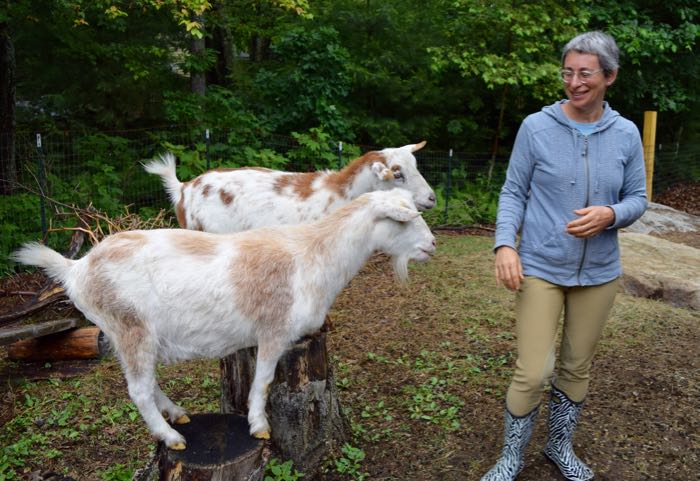
This is what I got:

They kept popping off and circling around. I quickly assessed the situation and realized that their view of Dr. Steph’s visit was different than mine. What was unimportant to me was glaringly obvious and serious to the Goaties.
Although I’d taught the goats to hop up on their tree trunks, I’d not taught that behavior with people standing on the far side, but that’s exactly where Dr. Steph and her assistant Kari were. That was cause for skittishness.
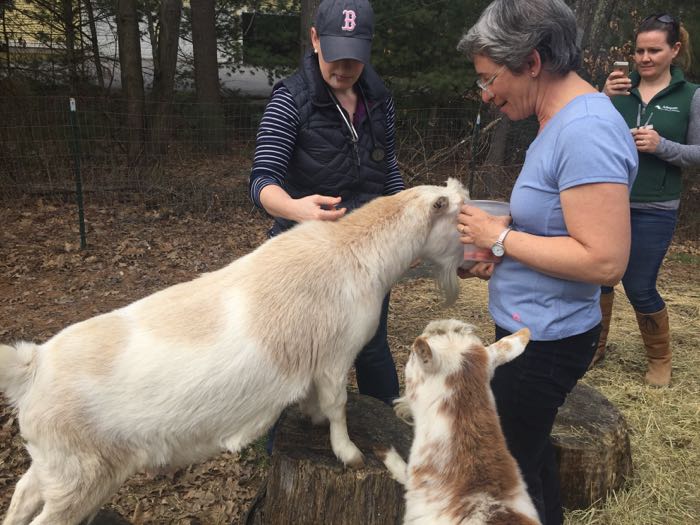
I asked our guests to stand in front of the stumps. Pip and Caper immediately relaxed.
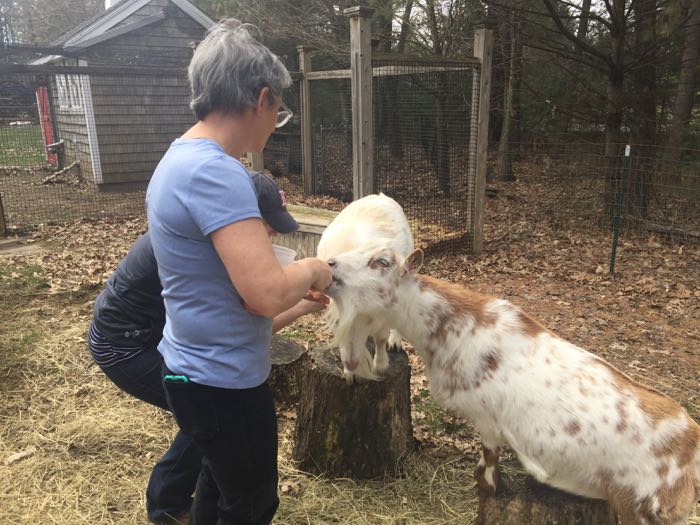
Because of arthritis, Caper can no longer stand on his stump (the high one in the middle) instead, he now puts two hooves on the smallest stump. In my human worldview, this wasn’t a big deal. A stump is a stump. Not to a goat! Pip saw his opportunity to claim the highest stump and was quite chuffed about it. He stood perfectly for the first of his two shots, but Pip hadn’t been trained to stay still on that stump, only the one to the left. Animals do see the world with that much specificity. Pip jumped down and joined his brother.
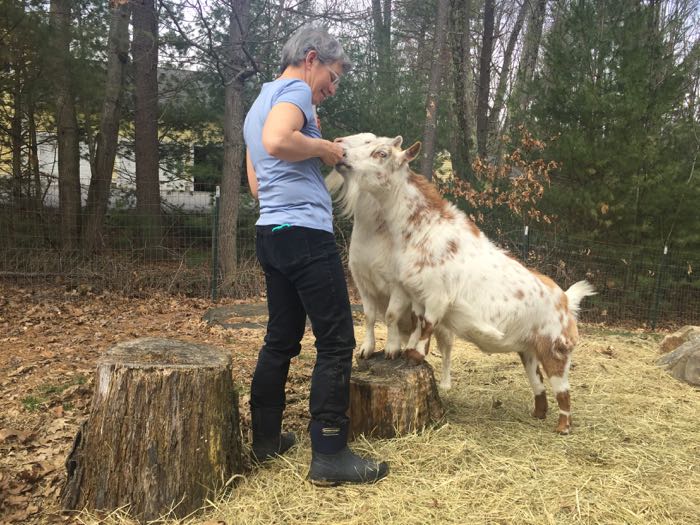
The Goat Boys do not stand politely next to each other. The above photo captured the calm before the behavior devolved into head butting shenanigans. So the next round of shots were done on the ground. I hadn’t trained specifically for this, but I had enough forethought to have a lot of carrots, which the goats will stay put for (if they’re fed rapidly enough.)
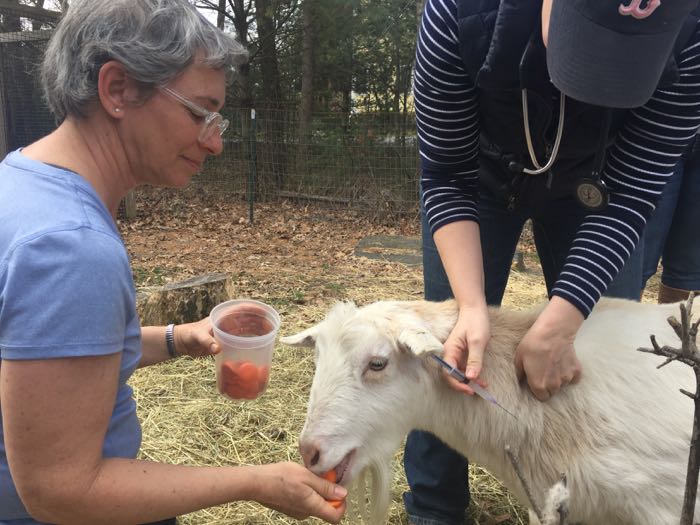
In the end, my “perfectly trained goats” did do what was needed, but on their own terms. Dr. Steph’s visit was a tad chaotic (typical of a life with goats) but it had nothing to do with the animals misbehaving, or being stubborn, or whatever other label one might use. Rather, Pip and Caper reminded me that the world that we navigate through is complex and that context matters.
What contextual element have you ignored during training, but that your animal let you know was very important?
The goats have long conversations with me about the true nature of the universe. They have lots to say. No talking necessary.



Thank you so much for that much needed reminder, many times I have been upset when my well behaved dogs seem to misbehave out of”spite”. Usually it was my anxiety, my too tight hold of their leash, my voice a full octave higher than normal, etc that caused this so-called bad behavior. The other day my husband and I were taking out some outdoor furniture from the shed to the deck and my hens (who follow me religiously, hoping for treats) scattered away from me in terror. Again I realized I was holding a large wooden chair over my head, it covered my hair (in their world my comb) very scary for a chicken!
Love you posts
Cindi
Chickens don’t recognize other chickens by their faces, rather by their combs – so I’d think that changing the shape of the top of your head would certainly concern them!
What I’d like to know is will Dr Steph come back again!
Yes! She had fun, and enjoyed seeing the Beast and Phoebe, too. Turns out she likes rabbits.
For what it’s worth I loved our visit and it did not feel one bit chaotic…I once had to vaccinate a herd of Katahdin sheep……have you ever met a Katahdin sheep? Context is irrelevant to them . Your goaties were perfectly gentlemen like! I look forward to our next caper and pip caper!
Thanks for saying that! Caper walking off with the needle still stuck in him was not exactly the behavior I hoped you see.
This is just too cute. That had to be really funny when they got into the head butting shenanigans.
One of my out of context training goof ups was teaching my filly to ground tie in the arena. She is just great there, but take her out of there and ground tie just doesn’t exist for her. Found that out the hard way. I need to work on that.
Everyone with a dog has gone through that. A dog trained to “come” across a backyard has not been trained to “come” in a park!
I love this. I love your goat boys and they look so much fun. What’s a bit of chaos as long as the job got done. Love the last photo.
This post really made me smile on whats been a horrible day. Love the boys thankyou for posting …:)
Cheering people up is what the Goaties do best. Sorry about your bad day.
I have been doing the sport of Canine Nosework with my dogs for about 5 years. The dog has to locate a q-tip which has been treated with an essential oil, birch oil for nosework 1, in 4 elements. The elements are containers, exterior search, interior search and vehicles. At our first trial, the interior search was in a classroom at an agricultural college. It wasn’t a huge room, and inside were a videographer, a timer, and two other officials. They basically just stand there silently which was super weird to my dog. My Golden Retriever just looked at me as if to say ” What’s with these people? No one is talking to me or scratching my ears.” Luckily, she trusted me enough to get down to work and search out the hidden q-tip. Also, the vehicle search was located next to a marshy area filled with quacking ducks. This was incredibly distracting especially for a Retriever. But again she got right to work and found that hide in 24 seconds! We ended up titling in Nosework 1 at that trial!
So interesting! A horse’s sense of smell is superlative. I’d love to see someone who is experienced with dog nose work do the same training with a horse. You should! 🙂